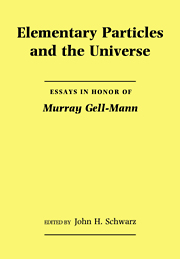Book contents
- Frontmatter
- Contents
- Preface
- Excess Baggage
- Through the Clouds
- Covariant Formulations of the Superparticle and the Superstring
- Chiral Symmetry and Confinement
- The Original Fifth Interaction
- The Mass Hierarchy of Leptons and Quarks as a New Symmetry
- Spacetime Duality in String Theory
- Supersymmetry and Quasi-Supersymmetry
- The Exceptional Superspace and the Quadratic Jordan Formulation of Quantum Mechanics
- Algebra of Reparametrization-Invariant and Normal Ordered Operators in Open String Field Theory
- Superconductivity of an Ideal Charged Boson System
- Some Remarks on the Symmetry Approach to Nuclear Rotational Motion
- Uncomputability, Intractability and the Efficiency of Heat Engines
- The New Mathematical Physics
- “Is Quantum Mechanics for the Birds?”
- The Gell-Mann Age of Particle Physics
- Remarks on the occasion of Murray Gell-Mann's more or less 60th Birthday
Some Remarks on the Symmetry Approach to Nuclear Rotational Motion
Published online by Cambridge University Press: 11 November 2009
- Frontmatter
- Contents
- Preface
- Excess Baggage
- Through the Clouds
- Covariant Formulations of the Superparticle and the Superstring
- Chiral Symmetry and Confinement
- The Original Fifth Interaction
- The Mass Hierarchy of Leptons and Quarks as a New Symmetry
- Spacetime Duality in String Theory
- Supersymmetry and Quasi-Supersymmetry
- The Exceptional Superspace and the Quadratic Jordan Formulation of Quantum Mechanics
- Algebra of Reparametrization-Invariant and Normal Ordered Operators in Open String Field Theory
- Superconductivity of an Ideal Charged Boson System
- Some Remarks on the Symmetry Approach to Nuclear Rotational Motion
- Uncomputability, Intractability and the Efficiency of Heat Engines
- The New Mathematical Physics
- “Is Quantum Mechanics for the Birds?”
- The Gell-Mann Age of Particle Physics
- Remarks on the occasion of Murray Gell-Mann's more or less 60th Birthday
Summary
ABSTRACT:
We discuss how Murray Gell-Mann contributed to the theory of nuclear rotational motion.
Introduction
Nuclear physics could hardly be called one of Murray Gell-Mann's primary interests, but it is our aim in the present note to show, nonetheless, that Murray did in fact make basic contributions to the theory of nuclear rotational motion. Of course—from the perspective of the next century—Murray Gell-Mann's introduction of quarks and SU3(color) will be seen as laying the very foundations of theoretical nuclear physics itself, so it will not be surprising to anyone (in that era) that he contributed to nuclear rotational theory.
Murray Gell-Mann developed his ideas, which we will discuss below, in the 1960's entirely in the context of particle physics and, although aware of their importance for other fields, he did not himself publish applications outside particle physics or field theory. By good fortune one of us (LCB) was a visiting faculty member at Cal Tech at this critical time and one day an invitation came to visit his office. During this visit he explained at some length the significance of his approach for nuclear physics, and for nuclear rotational motion in particular, and suggested that these ideas be followed up. It was in this way that Murray's ideas made their way into the nuclear physics literature.
- Type
- Chapter
- Information
- Elementary Particles and the UniverseEssays in Honor of Murray Gell-Mann, pp. 157 - 174Publisher: Cambridge University PressPrint publication year: 1991

